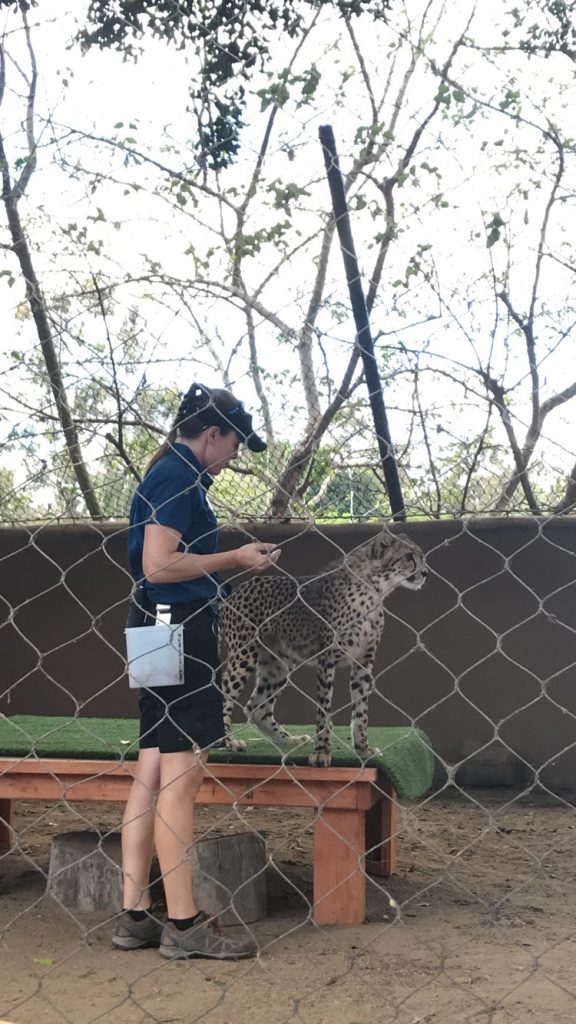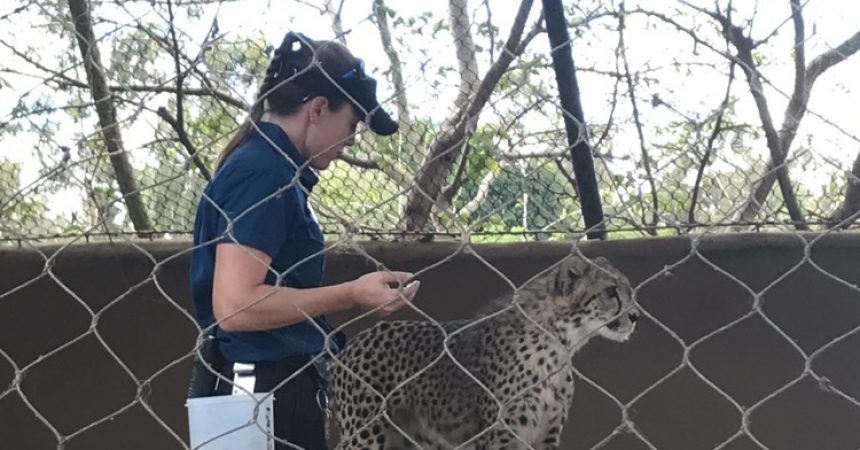Zoo InternQuest is a seven-week career exploration program for San Diego County high school juniors and seniors. Students have the unique opportunity to meet professionals working for the San Diego Zoo, Safari Park, and Institute for Conservation Research, learn about their jobs, and then blog about their experience online. Follow their adventures here on the Zoo’s website!
 Napping all day and only waking up for food and a quick run, cheetahs are not unlike our beloved house cats. However, at two to three feet tall and weighing 84 to 143 pounds they are much larger than your average house cat. The San Diego Zoo recently acquired two cheetah cubs, female Roketi and male Jabula. It is easy to tell that Roketi and Jabula are still young cheetah cubs from the mohawk that fans up from their upper back called a mantel. This mantel will go away once the cubs are about a year old, but for now, they continue to sport their fashionable fluffy hair. Cheetah cubs use this mantel to camouflage in tall grasses of the African Savannah.
Napping all day and only waking up for food and a quick run, cheetahs are not unlike our beloved house cats. However, at two to three feet tall and weighing 84 to 143 pounds they are much larger than your average house cat. The San Diego Zoo recently acquired two cheetah cubs, female Roketi and male Jabula. It is easy to tell that Roketi and Jabula are still young cheetah cubs from the mohawk that fans up from their upper back called a mantel. This mantel will go away once the cubs are about a year old, but for now, they continue to sport their fashionable fluffy hair. Cheetah cubs use this mantel to camouflage in tall grasses of the African Savannah.
Both these cheetah cubs are still young, and very much rambunctious, as they run and play in their exhibit. In the wild, cheetahs are known for being some of the fastest land animals in the world, reaching speeds up to 70 miles per hour. However, in the wild, cheetahs often times will only run when they need to find prey, or when they get the “zoomies”. As described by Ms. Elkins, a San Diego Zoo Lead Trainer, this is when after they nap all day, they need to run around and play in order to get out their pent up energy. The cheetahs impressive running ability is due to their body structure. Not only do cheetahs have a highly flexible spine, allowing their front legs to stretch in front of them lunging forward in long strides, but they also have special features in their claws. Cheetah claws, unlike many large wild and domesticated cats, are very hard and dulled at the tips. While the claws remain sharp enough to capture prey, their constant exposure to their environment keeps them filed down. This is in part because cheetah claws are not retractable like most cat species. Cheetah claws can be more closely related to that of a dog.
Cheetahs inhabit parts of Africa and a small population is still surviving in Iran. However, cheetah populations are in steep decline with only 7,000 cheetah left in the wild. This is down from as many as 100,000 just 100 years ago. This is mainly due to habitat destruction by humans, the need for human resources, and exotic pet trade. Today, cheetahs are classified as an endangered species, but there is still hope. Through the San Diego Zoo’s partnerships with conservation organizations such as the Cheetah Conservation Fund (CCF) in Namibia and the national cheetah Breeding Center Coalition (BCC), the Zoo can help aid cheetahs in the wild and help to save their natural habitat. In addition to working to save cheetahs on a global front, the Zoo is also working within their own organization to combat cheetah population decline.
One way the San Diego Zoo is helping cheetahs is through training. Through training, Zoo Trainers, like Ms. Elkins, help animals exhibit natural behaviors that they would in the wild. By building trust with these animals, trainers can also help with vital research projects that can be used to further the protection of cheetahs in the wild. Currently Zoo Trainers are helping gather data for a new research project that tests the effect of cheetah interactions with dogs on a cheetah’s stress levels. This is a way for trainers to exhibit how learned behaviors can benefit cheetahs in the wild, while helping to maintain the health of cheetahs that are living in managed care.
Cheetahs are rapidly disappearing in their natural habitat, and while the San Diego Zoo is doing everything they can to help, there are ways that everyone can help. By increasing awareness about what we buy and how our products impact wildlife, we can help save the cheetahs. If you want to help the cheetahs and other endangered species you can download the app Cheyenne Mountain to check your food products for harmful ingredients, like unsustainable palm oil, and if you become aware of illegal wildlife trafficking contact the Cheetah Conservation Fund. We have the power to save endangered wildlife and help cheetahs prosper in the wild once again.
Casey, Species Spotlight Team
Week one, Fall Session 2018


